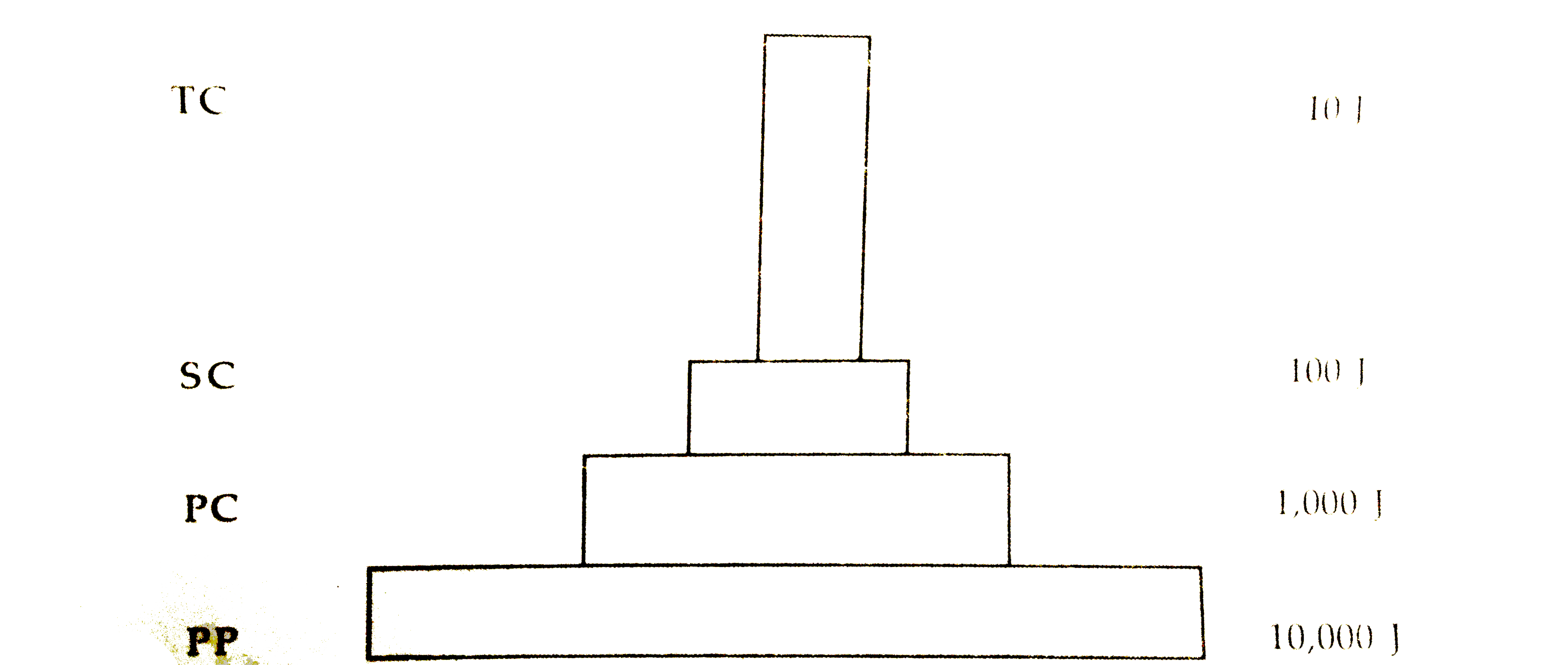It is often said that the pyramid of energy is always upright. On the other hand, the pyramid of biomass can be both upright and inverted." Explain with the help of example and sketches .
Step-by-Step Solution
1. Understanding Ecological Pyramids:
- Ecological pyramids represent the distribution of energy, biomass, or numbers of organisms at each trophic level in an ecosystem. The two types we will focus on are the pyramid of energy and the pyramid of biomass.
2. Pyramid of Energy:
- The pyramid of energy illustrates the flow of energy through different trophic levels in an ecosystem. It is always upright because energy transfer is unidirectional and decreases at each trophic level.
- According to the 10% law of energy transfer, only about 10% of the energy from one trophic level is transferred to the next. This means that producers (like plants) have the highest energy, followed by primary consumers (herbivores), secondary consumers (carnivores), and tertiary consumers (top predators).
Sketch:
E≠rgyPyram∣∣TertiaryCon∑ers(TopPreda→rs)∣∣SecondaryCon∑ers(Carnivores)∣∣PrimaryCon∑ers(Herbivores)∣∣Producers(Plants)
3. Pyramid of Biomass:
- The pyramid of biomass represents the total mass of living matter at each trophic level. This pyramid can be either upright or inverted depending on the ecosystem.
- Upright Pyramid Example: In terrestrial ecosystems like grasslands and forests, the biomass of producers is greater than that of primary consumers, which is greater than that of secondary consumers.
Sketch:
BiomassPyram:∣∣TertiaryCon∑ers(Le∗Biomass)∣∣SecondaryCon∑ers∣∣PrimaryCon∑ers∣∣Producers(MostBiomass)
- Inverted Pyramid Example: In aquatic ecosystems, the biomass of tertiary consumers (like large fish) can be greater than that of primary consumers (like zooplankton), which can be greater than that of producers (like phytoplankton).
Sketch:
BiomassPyram:∣∣TertiaryCon∑ers(MostBiomass)∣∣SecondaryCon∑ers∣∣PrimaryCon∑ers∣∣Producers(Le∗Biomass)
4. Conclusion:
- The pyramid of energy is always upright due to the unidirectional flow of energy and the 10% energy transfer rule. In contrast, the pyramid of biomass can be upright or inverted depending on the specific ecosystem and the relationships between producers and consumers.
- Ecological pyramids represent the distribution of energy, biomass, or numbers of organisms at each trophic level in an ecosystem. The two types we will focus on are the pyramid of energy and the pyramid of biomass.
- The pyramid of energy illustrates the flow of energy through different trophic levels in an ecosystem. It is always upright because energy transfer is unidirectional and decreases at each trophic level.
- According to the 10% law of energy transfer, only about 10% of the energy from one trophic level is transferred to the next. This means that producers (like plants) have the highest energy, followed by primary consumers (herbivores), secondary consumers (carnivores), and tertiary consumers (top predators).
E≠rgyPyram∣∣TertiaryCon∑ers(TopPreda→rs)∣∣SecondaryCon∑ers(Carnivores)∣∣PrimaryCon∑ers(Herbivores)∣∣Producers(Plants)
- The pyramid of biomass represents the total mass of living matter at each trophic level. This pyramid can be either upright or inverted depending on the ecosystem.
- Upright Pyramid Example: In terrestrial ecosystems like grasslands and forests, the biomass of producers is greater than that of primary consumers, which is greater than that of secondary consumers.
BiomassPyram:∣∣TertiaryCon∑ers(Le∗Biomass)∣∣SecondaryCon∑ers∣∣PrimaryCon∑ers∣∣Producers(MostBiomass)
BiomassPyram:∣∣TertiaryCon∑ers(MostBiomass)∣∣SecondaryCon∑ers∣∣PrimaryCon∑ers∣∣Producers(Le∗Biomass)
- The pyramid of energy is always upright due to the unidirectional flow of energy and the 10% energy transfer rule. In contrast, the pyramid of biomass can be upright or inverted depending on the specific ecosystem and the relationships between producers and consumers.
Topper's Solved these Questions
- XII BOARDSBOOK - XII BOARD PREVIOUS YEAR PAPER ENGLISHCHAPTER - XII BOARDSEXERCISE - Set-I
143 Videos
- XII BOARDSBOOK - XII BOARD PREVIOUS YEAR PAPER ENGLISHCHAPTER - XII BOARDSEXERCISE - SET-III
46 Videos
- SAMPLE PAPER 2019BOOK - XII BOARD PREVIOUS YEAR PAPER ENGLISHCHAPTER - SAMPLE PAPER 2019EXERCISE - Section E Part B
3 Videos
Similar Questions
Knowledge Check
An inverted pyramid of biomass can be found in which ecosystem?
AForestBMarineCGrasslandDTundra
Which of the folllowing ecological pyramids can be both upright and inverted?
View SolutionAn inverted pyramid of biomass can be found in which ecosystem
View Solution$ Pyramid of Energy is always upright
! Pyramid of biomass is always inverted.
View SolutionAn inverted pyramid of biomass can be found in which ecosystem?
View SolutionUnder what condition, the upright pyramid of biomass becomes inverted?
View SolutionAlways upright shape of pyramid is in :
View SolutionIn which of the following ecosystem pyramids are always upright?
View Solution

